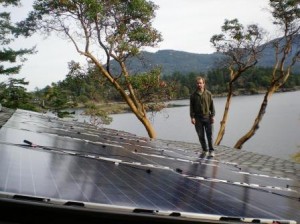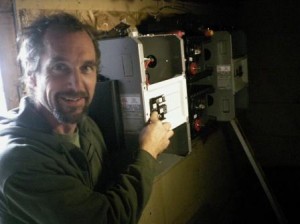
Jeffrey Utter, installing solar panels on roof of Eastsound home last week
Oil is dirty, costly and unsustainable. Sunshine is clean, free and accessible – providing solar power as an energy source is one of the ways in which our culture is changing.
An Eastsound waterfront home is the scene for the installation of solar electric panels that will produce not only clean power, but a first-year tax credit from the federal government and reduction in monthly utility bills.
Last week, Jeffrey Utter of Home and Energy Solutions, was climbing to the roof and crouching in the basement of a home, installing solar panels and the power conversion system. Utter, now working out of Bellingham, has been coming to his family’s place on Orcas since he was a child, and his uncle (known around Orcas Island as Judge Utter) used to own the property surrounding Eagle Lake.
His current project is a San Juan Islands first, in that, by using all Washington-produced technology, Utter’s client benefits from significant incentives, tax breaks and utility rebates.
The Federal government gives a 30 percent tax credit for “green” energy use, such as solar-electric panels, wind power and some conservation measures. And the sales tax charged on the equipment and installation is also waived.
Use of qualified micro-hydro and solar-electric power components brings a 15-cent per kilowatt-hour credit. If the solar panels are produced in Washington, there is an additional 18 cents per KW hour credit.
In total, a project such as the one Utter is working on results in a whopping 54-cents per kilowatt hour rebate, in partnership with OPALCO.
Finally, OPALCO coop members can “bank” the kilowatt-hours that they don’t use, with a turnover date set annually.

Utter installs the transformer panel in the basement of the home
Utter and his partners were approached for a solar installation project at a trade fair in Whatcom County by Orcas residents who also have a home near Bellingham. The project involves two major components: installing the roof panels and installing the power center which meters the amount of solar electricity produced by the solar panels and converts the power into energy that can be used by the utility company.
Utter estimates that a 4,100 watt system will produce about 4,500 KW hours per year.
The cost for such a project, installed, is $42,000, but the owners estimate they will recoup that amount in 7 or 8 years, which is “substantially less obligation [to the homeowner] for the life of the system,” says Utter.
The initial 30 percent Federal tax credit comes right at the start of the system’s lifespan, and the homeowners can expect to see a 60 percent reduction in their power bill, “effective immediately.”
Utter has partnered with three other specialists in their fields to bring the alternative energy supply of solar-electricity to homeowners. Byron Seegers, head of Advanced Solar Energy, is the sales and business expert. Eric Yurk is the electrician and Tom Anderson is the engineer in the conglomerate.
Seegers says, “longer term, the up-front cost is mitigated by tax benefits and cash flow. The residual benefit is it frees up 50 percent of electricity costs.”
Utter has 20 years experience and says “now is the time to be doing this.”
**If you are reading theOrcasonian for free, thank your fellow islanders. If you would like to support theOrcasonian CLICK HERE to set your modestly-priced, voluntary subscription. Otherwise, no worries; we’re happy to share with you.**







